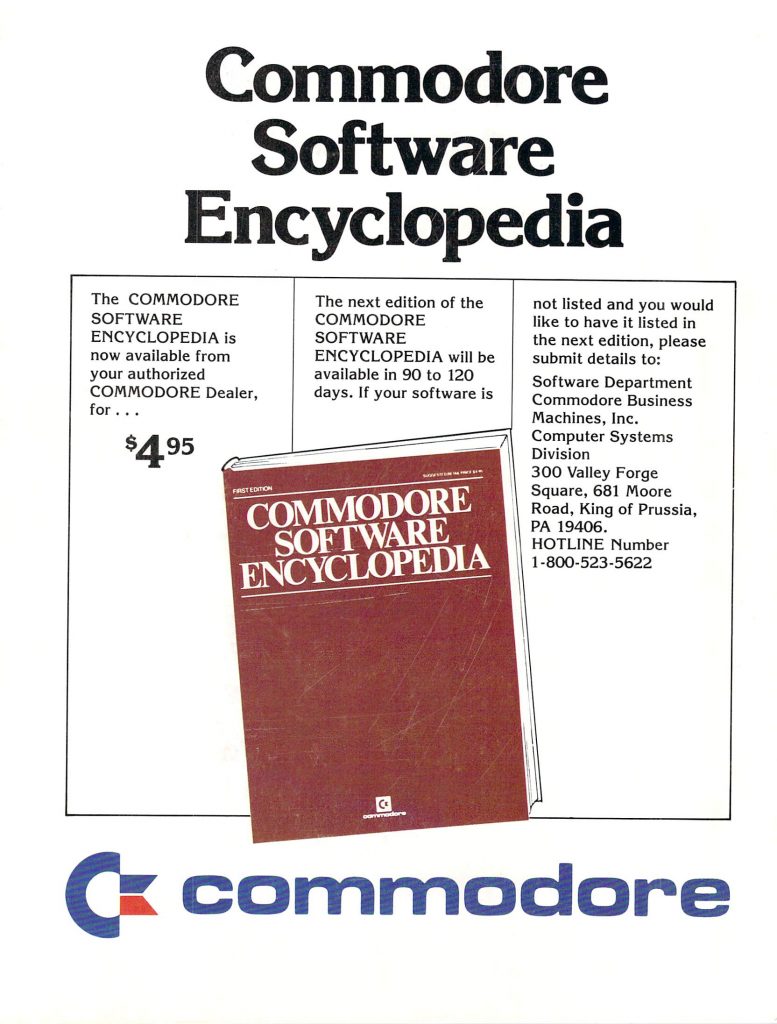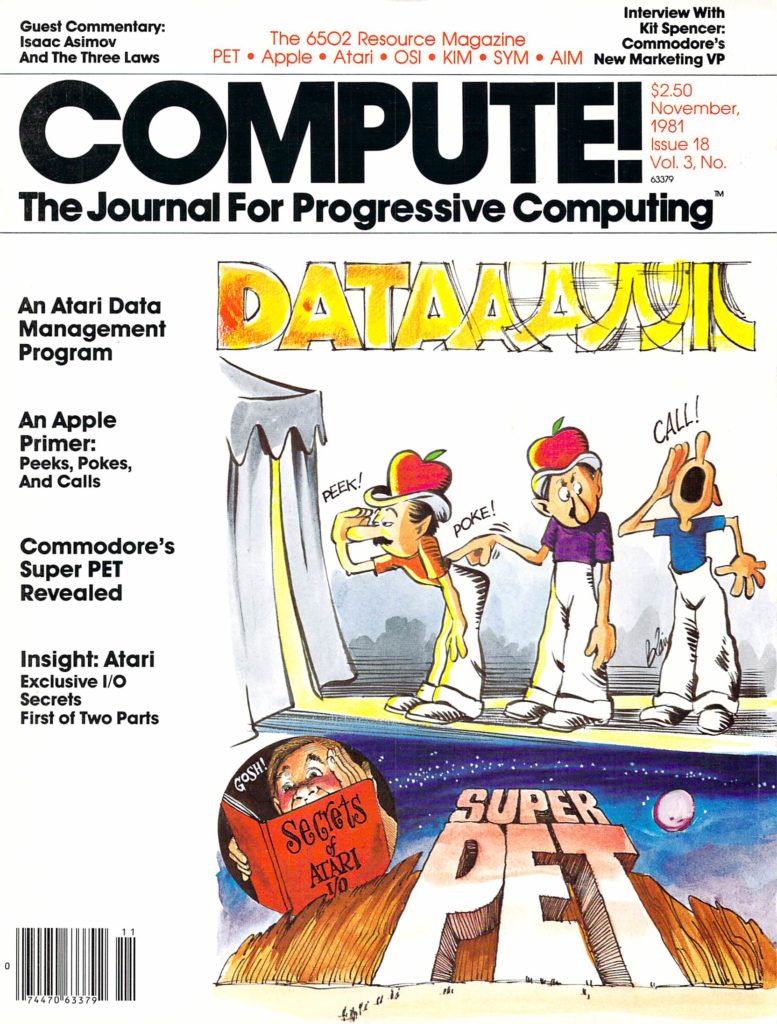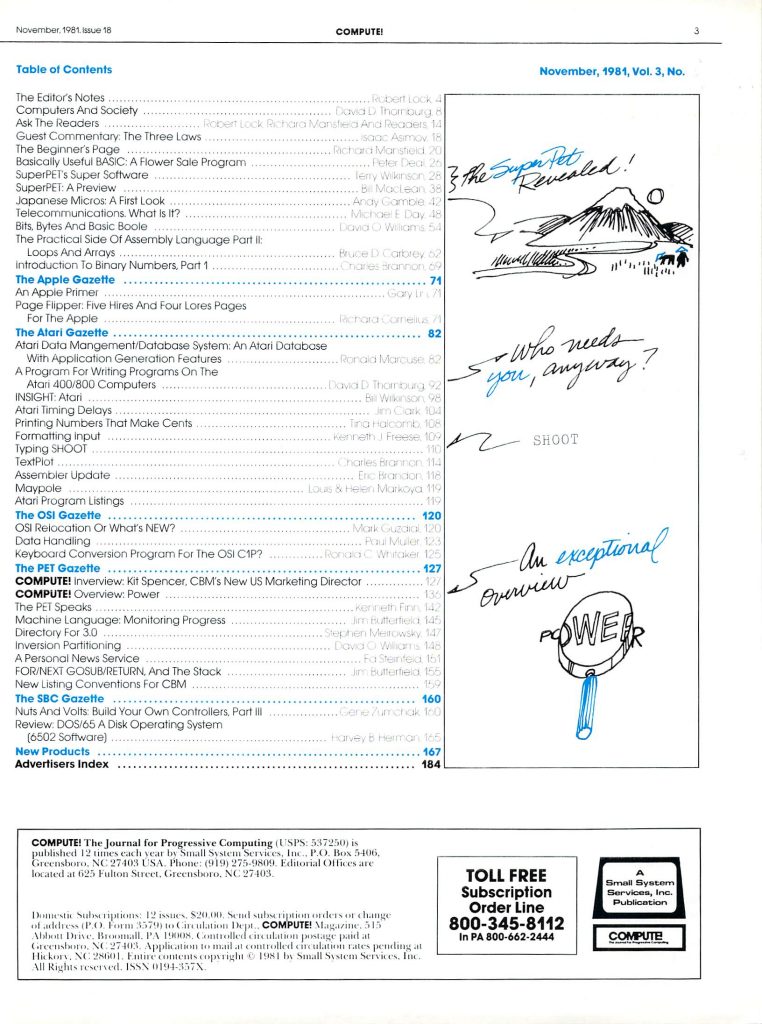Source: Compute! – Issue Number 18 – November 1981
Compute! was one of the better multi-format computer magazines of the 1980s (and early 1990s). In 1981, Compute! was focused on computers based on the 6502 CPU. At the time, this included the Commodore PET, Atari 8-bit and Apple II in addition to more obscure entries like the KIM and others. The November 1981 issue includes:
Table of Contents
- The Editor’s Notes – Atari educational sales in Minnesota; a preview of the SuperPET coverage in this issue; Recreational Computing merges with Compute!; and more.
- Computers and Society – Simplifying computer interfaces to make home computers a mass market success.
- Ask the Reader – Questions asked and answered by readers. Some topics in this issue include interfacing the Vortax Type ‘N Talk speech synthesizer to the Atari 800; graphics modes 9-11 on the Atari 400/800; the Commodore 4010 Voice Synthesizer; sequential file access on the OSI C3; and operating a Commodore 3016 and 3040 floppy drive via a marine 12v battery.
- Guest Commentary: The Three Laws – Isaac Asimov writes about applying/adapting the Three Laws of Robotics to other things.
- The Beginner’s Page – An example of creating a database management program in BASIC.
- Basically Useful BASIC: A Flower Sale Program – A BASIC program written for the PET that keeps track of flower sales for a Cub Scout Den.
- SuperPET’s Super Software – A look at the University of Waterloo’s design and use of the new Commodore SuperPET, a modification of the existing Commodore PET (8032) that adds a 6809 processor among other enhancements.
- SuperPET: A Preview – A preview of the new Commodore SuperPET which enhances the original design by adding an additional 64K of RAM, the addition of a 6809 processor, and improvements to the I/O system.
- Japanese Micros: A First Look – A summary of various computers available in Japan, including the Sharm MZ-80B (Z80A @ 4.7MHz with 64k of RAM), the NEC PC-8000 Series (PD780C-1 CPU @ 4MHz), the Casio FX-9000P (Z80A @ 2.75MHz and up to 32K of RAM), the Fujitsu Micro 8 (dual 6809 processors and 32K of available RAM), the Bubcom 80 (Z80-based with 64K of RAM), and several others.
- Telecommunications. What is It? – An introduction to how modems work.
- Bits, Bytes, and Basic Boole – How to use AND, OR, and NOT in BASIC.
- The Practical Side of Assembly Language Part II: Loops and Arrays – Using loops and arrays in assembly and some of the differences vs. BASIC.
- Introduction to Binary Numbers, Part 1 – The first part of a guide to binary numbers, including converting from binary to decimal.
The Apple Gazette
- An Apple Primer – Using PEEKs, POKEs and CALLs on the Apple II.
- Page Flipper: Five Hires and Four Lores Pages for the Apple – Storing graphics and text in memory and switching between them.
The Atari Gazette
- Atari Data Management/Database System: An Atari Database – A database management system in BASIC to type in for your Atari.
- A Program for Writing Programs on the Atari 400/800 Computers – This type-in program that will create BASIC statements for you based on a series of questions.
- INSIGHT: Atari – The first of a multi-part series of interacting with Atari I/O via assembly.
- Atari Timing Delays – A program for creating a precise timing delay in Atari BASIC.
- Printing Numbers That Make Cents – A BASIC routine to print consistently formatted numbers, particularly for currency representation.
- Formatting Input – Two BASIC routines for inputting data via a table.
- Typing SHOOT – Some hints for typing in programs to reduce the possibility of errors.
- TextPlot – A type in program for creating graphs that can be labeled.
- Assembler Update – An update to a type-in program from an earlier issue. This adds SAVE and LOAD commands to Assembler in BASIC.
- Maypole – A type-in graphics demo using obscure Atari graphics modes.
The OSI Gazette
- OSI Relocation Or What’s NEW? – Relocating BASIC programs and using the NEW command on OSI machines.
- Data Handling – A guide to handling data on the OSI Superboard.
- Keyboard Conversion Program For The OSI C1P – Dealing with the non-standard keyboard behavior of the OSI C1P and Superboard.
The PET Gazette
- COMPUTE! Interview: Kit Spencer, CBM’s New US Marketing Director – Some background on Kit Spencer, differences in marketing between the U.S. and U.K., the future of technology (an LED TV is mentioned) in general and the future of Commodore specifically.
- COMPUTE! Overview: Power – An overview of POWER which is a ROM chip that plugs into the PET to provide additional BASIC commands.
- The PET Speaks – A program for the PET that allows it to reproduce speech from audio cassettes.
- Machine Language: Monitoring Progress – A guide to using the machine language monitor on the PET.
- Directory For 3.0 – A program for displaying a disk directory from your own program when using BASIC 3.0.
- Inversion Partitioning – A method of partitioning memory to store more than one BASIC program at a time.
- A Personal News Service – Converting the PET into a VAX terminal.
- FOR/NEXT GOSUB/RETURN, And The Stack – A program for examining the stack to help debug issues with loops and GOSUB statements.
The SBC Gazette
- Nuts and Volts: Build Your Own Controllers, Part III – Part 3 of an ongoing series about building a controller using a single board computer and using a home computer as a development system.
- Review: DOS/64 A Disk Operating System (6502 Software) – Using DOS/64 with the KIM.
- New Products – New products looked at this month include Home Accounting System for the Atari, The Depreciation Planner for the Apple II, an 80 Column adapter for the Commodore PET/CBM, the PEDISK II Floppy Disk System for the Rockwell AIM, Graphics Composer for the Atari 400/800, and more.

…and more!








